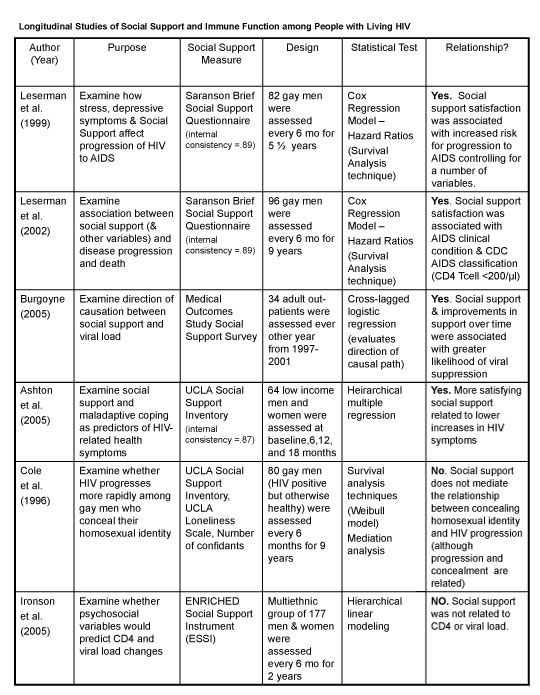Health Behavior and Health Education
theory, research, and practice
theory, research, and practice
The next important step in determining if the social networks and social support model could be used to explain a particular health outcome is to consult the research literature. Reviewing previously conducted studies provides evidence for or against the use of social networks and social support to explain different health outcomes in different populations.
Since the social networks and social support model includes a number of hypothesized pathways, it is helpful to identify which relationship(s) are under investigation. Based on this information, one can determine whether the study design and data analysis techniques employed allow the particular pathway to be tested and appropriate conclusions drawn.
This section provides an overview of selected findings from the social networks and social support literature.
There is a vast body of research concerning relationships between social networks and social support and various mental and physical health outcomes from susceptibility to a common cold virus to cardiovascular disease mortality. For an extensive review of social networks and social support and health outcomes consult the following articles:
Berkman, L.F., Glass, T., Brissette, I., & Seeman, T.E. (2000). From social integration to health: Durkheim in the new millennium. Social Science and Medicine, 51, 843-857.
Cohen, S. (2004). Social relationships and health. American Psychologist, 59(8), 676-684.
Uchino, B. (2006). Social support and health: A review of physiological processes potentially underlying links to disease outcomes. Journal of Behavioral Medicine, 29(4), 377-387.
Given the number of studies of social networks and social support, it may be helpful to concentrate on empirical testing of one particular health outcome. Furthermore, exploring an area where there is no consensus regarding relationships found in previous studies may provide added benefit.
Therefore, this section highlights an area where findings are less clear - HIV and social support. Measurement, study design and data analysis methods employed in recent investigations of this topic will be compared to evaluate study findings and conclusions.

Since there are so few studies of social support and immune function in HIV positive populations (with longitudinal study designs and using appropriate statistical techniques) it is difficult to make conclusive statements. However, the results appear promising. Ironson (2005) did not find a significant relationship between social support and viral load. They acknowledged using a single item to assess each type of social support may have affected findings.
Although the study designs and statistical analyses techniques increase confidence in the findings, future studies may benefit from mediation analysis.
For more information, study citations are listed below:
Ashton, E., Vosvick, M., Chesney, M., Gore-Felton, C., Koopman, C., O'Shea, K. et al. (2005). Social support and maladaptive coping as predictors of the change in physical health symptoms among persons living with HIV/AIDS. AIDS Patient Care and STDs, 19(9), 587-598.
Burgoyne, R. W. (2005). Exploring direction of causation between social support and clinical outcome for HIV positive adults in the context of highly active antiretroviral therapy. AIDS Care, 17(1), 111-124.
Cole, S.W., Kemeny, M.E., Taylor, S.E., Visscher, B.R., & Fahey, J.L. (1996). Accelerated course of Human Immunodeficiency Virus infection in gay men who conceal their homosexual identity. Psychosomatic Medicine, 58, 219-231.
Ironson, G., O'Clleirigh, C., Fletcher, M.A., Laurenceau, J. P., Blabin, E., Klimas, N., Schneigerman, N. (2005). Psychosocial factors predict CD4 and viral load change inmen and women with Human Immunodeficiency Virus in the era of highly active antiretroviral treatment. Psychosomatic Medicine, 67, 1013-1021.
Leserman, J., Jackson, E.D., Petitto, J.M.,, Golden, R.N., Silva, S.G., Perkins, D.O. et al. (1999). Progression to AIDS: The effects of stress, depressive symptoms, and social support. Psychosomatic Medicine, 61, 397-406.
Leserman, J. Petitto, J.M., Gu, H., Gyanes, B.N., Barroso, J., Golden, R.N. et al. (2002). Progression to AIDS, a clinical AIDS condition and mortality: Psychosocial and physiological predictors. Psychological Medicine, 32, 1059-1073.
When evaluating empirical testing, one should consider several questions:
Future direction: